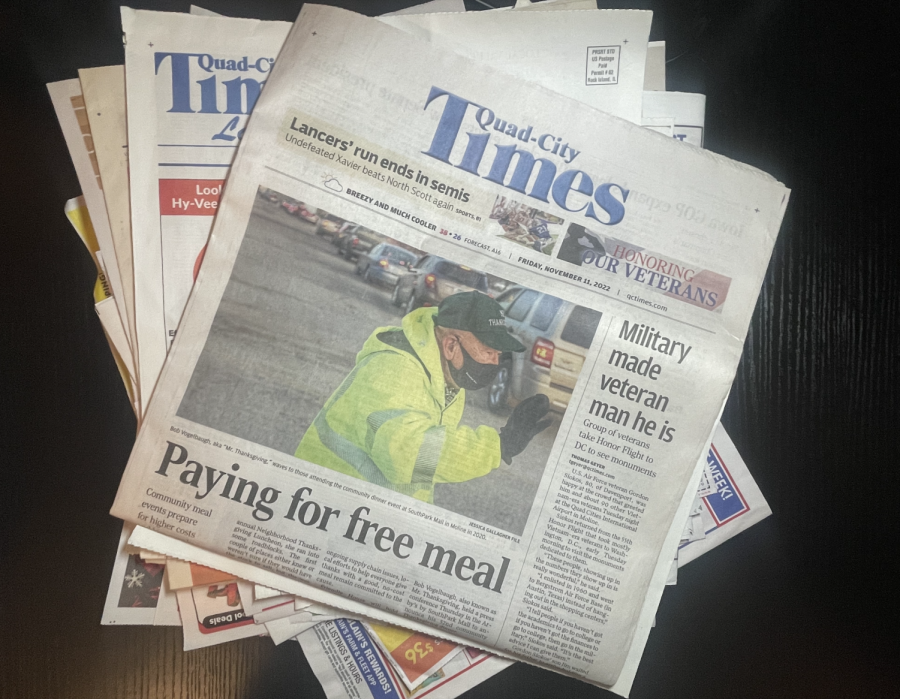With the ever-encroaching shift to digital media, the print news sector has seen an inevitable decline. Some publishers like The New York Times have adapted to the changing media landscape, more than compensating for its loss in print subscribers with digital news.
But others are bleeding, and their dying out has only been exacerbated by large publishing companies. Most vulnerable to the changing medium of journalism are the local, daily newspapers that are managed by large publishing companies.
For over a century, Gannett, America’s largest newspaper publishing company, has been experiencing cuts for many of the 100+ years that it has been in operation. The company publishes big newspapers like USA Today, as well as many local papers, including Detroit Free Press, Arizona Republic and our very own Des Moines Register.
In 2019, Gannett merged with newspaper giant GateHouse Media, sharing around 25,000 employees within the two companies and establishing the country’s largest newspaper chain. After only four years, the size of their workforce declined by nearly 14,000 and the number of newspapers in circulation saw a decline of at least 52%.
A company that dominated 261 daily and 302 weekly newspapers in 2019, now drastically reduced its number of clients to 217 daily and 175 weekly newspapers in 2022. USA Today is arguably the company’s most prominent client, which once sold on the racks of every store in America. But even its best-known paper hasn’t been particularly profitable— its daily circulation decreased from 579,692 in 2018 to 134,629 in 2022.
In comparison, local newspapers not managed by Gannett were able to alleviate their loss in print subscribers with digital subscriptions. For instance, The Seattle Times lost 62,000 print readers from 2019 to 2022, but gained 52,000 digital subscribers.
Take the largest newspaper in Iowa, the Des Moines register, for example. This newspaper, managed by Gannett publishing, has lost nearly 70% of its circulation since 2018.
Even more unfortunate, the recent Senate File 480 bill approved by the Iowa Senate would eliminate long-standing requirements for public notices to be published in newspapers, a form of revenue that print newspapers rely on to keep them afloat.
Though it may appear that there are plenty of other alternatives to local print newspapers, the nearing end of print news has resulted in the increased prevalence of “news deserts” — areas where local, daily newspapers were not able to thrive in the cutthroat ecosystem where digital media flourishes.
So what happens in the aftermath of a closure? The unfortunate reality is that not every community is so lucky to have another agency step in when a local newspaper stops reporting.
Local TV stations do their best to keep up with the basics, but not nearly as in-depth as a print newspaper. Even mainstream media often only reports one side of important stories. All the newspapers in the world cannot come close to covering all the stories that should be covered within the community or state.
As the co-editor-in-chief of Pleasant Valley High School’s print newspaper, The Spartan Shield, senior Makenna Leiby has witnessed the positive effects of print media first-hand. “Students are excited to pick up new editions to read about their fellow students or appreciate the dedication of the publication’s staff,” she said. “Recurring elements like senior spotlights or athlete features are what draw our readers in, making it apparent to me that the familial feeling of print newspapers is what readers appreciate most. Online news sources can never bring the same sense of community that print media can.”
Less local press means less coverage of city council meetings, less informed voters on local issues or even less recognition for the local football team that won their first state championship.
Leiby believes that the closure of local newspapers will drastically change communities. “Smaller news stations often focus on community members and local happenings, so the loss of these institutions will leave suburban communities without recognition. Local newspapers mainly serve the purpose of bringing people together and allowing people to feel important, and without them communities will be isolated,” she said.
Often, the communities that need quality reporting the most are the places where a print newspaper or digital company cannot sustain itself. A graphic produced by Medill’s Local News Initiative illustrates the drastic differences to news access based on geographic location.
As an industry, journalism is already struggling. As newsrooms experience closures, many journalists are afraid to enter the profession, and as the number of journalists decline, newsrooms continue to close— the cycle perpetually continues.
This cycle is creating a crisis for our democracy, and its implications are going unnoticed. While local newspapers continue to shut down, everyone becomes less educated about the world around them. More than ever, we need reliable news from reputable sources, and local reporting is crucial to building a community of informed citizens.









